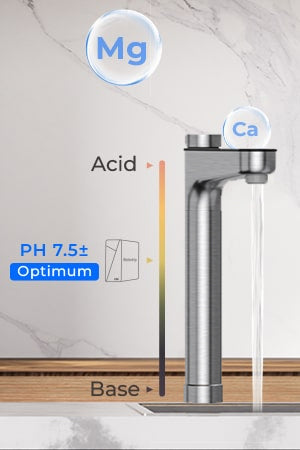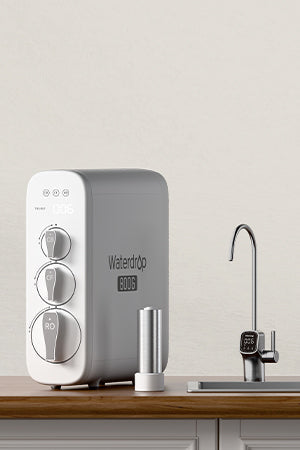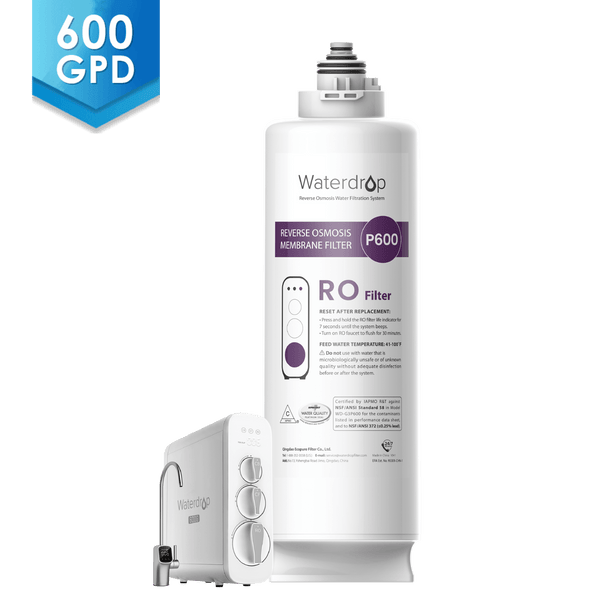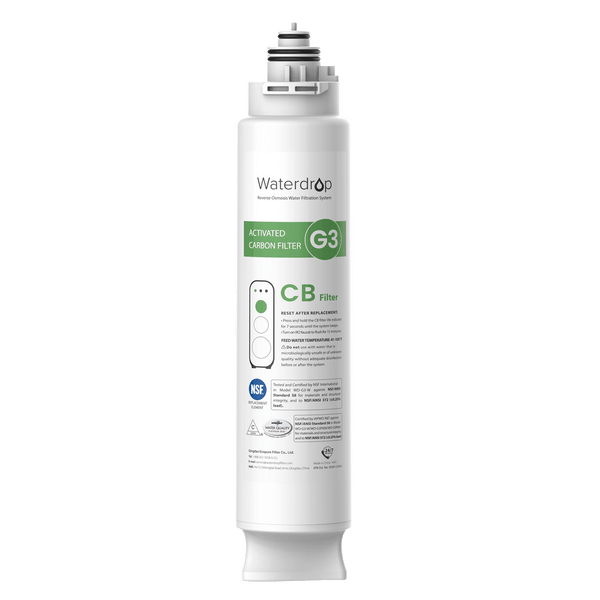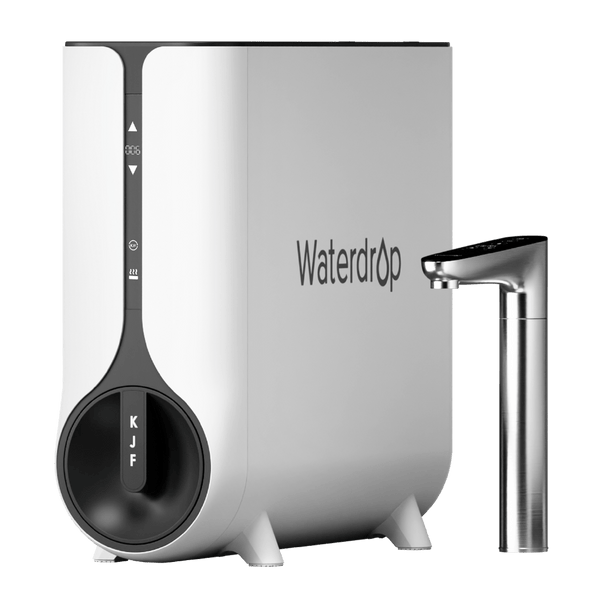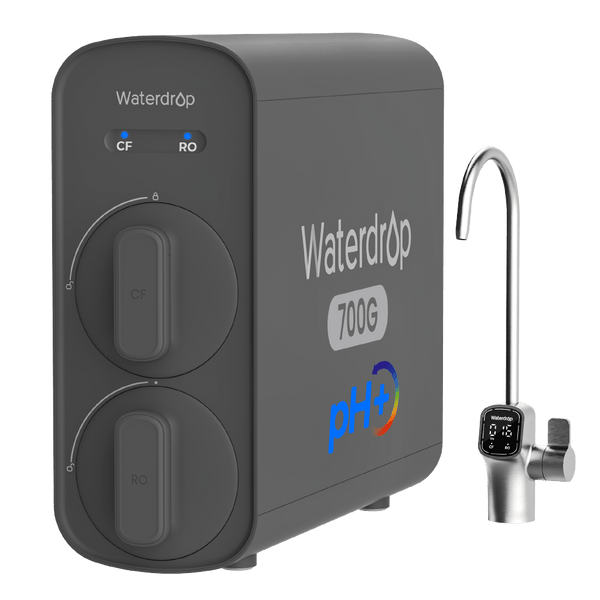| Waterdrop G3P600 RO system | Waterdrop G3 RO system | Traditional RO system | |
|---|---|---|---|
| Tankless design | ✔ | ✔ | ✖ |
| flow rate | 600GPD | 400GPD | 50-100GPD |
| Intelligent leak protection | ✔ | ✔ | ✖ |
| 3s filter change time | ✔ | ✔ | ✖ |
| Pure water to the drain | 2:1 | 1 : 1 | 1:3 |
| real-time water quality display | ✔ | ✔ | ✖ |
600 Gallons Per Day Tankless Reverse Osmosis Water Filter - Waterdrop G3P600

600 Gallons Per Day Tankless Reverse Osmosis Water Filter - Waterdrop G3P600
model number
WD-G3P600
certification
NSF/ANSI 58 & 372
In to Drain
2:1
materials
System housing: BPA-free plastic
Faucet: Intelligent display faucet
RO filter: reverse osmosis membrane
CB filter: carbon block
CF filter: PP cotton & carbon block
cable length
90 inches
product dimensions
18.11 x 5.67 x 17.73 inches
item weight
32.4 pounds
scope of delivery
System cover, Smart Screen faucet, RO filter, CF filter, CB filter, PE pipes *3 (60 inches), T-piece, Drain saddle, Securing clips, Power adapter (Main power cord 90 inches, Faucet power cord 59 inches)
faucet
Smart Screen Faucet
flow rate
0.42 gallons per minute (GPM), 600 gallons per day (GPD)
indoor or outdoor use
For indoor use only
wall plug
Yes
Terms of Use
Ice machines, faucets, aquariums, mobile homes
An electrical outlet is required to operate the reverse osmosis system.
Reduced substances
TDW, chlorine, taste and odor, chloramine, lime, turbidity
Carcinogenic substances: Chromium (hexavalent), Chromium (trivalent), Cadmium and
cadmium compounds, iron oxide
Heavy metals: lead, mercury, barium, copper, radium 226/228, aluminum
Microorganic contaminant: cyst
Inorganic pollutants: arsenic and inorganic arsenic compounds, fluoride
Organic pollutants: asbestos, benzene, formaldehyde, nitrite bisphenol A, trichloromethane,
Chlordane, PFOA & PFOS and more
What is the difference between Waterdrop and traditional RO systems?
What is the ratio of pure water to wastewater?
What's new about the Waterdrop G3P600 RO water filter system?
What is a reverse osmosis water system?
How does a reverse osmosis system work?
Does the reverse osmosis water system produce wastewater?
What contaminants can the Waterdrop reverse osmosis water filter system remove?
Does the Waterdrop reverse osmosis water filter system require electricity?
How to install a reverse osmosis system?
How often do I need to change the RO filter?
Does the reverse osmosis system make a lot of noise?
Do you have to turn off the water when changing the filters?
Does the RO system remove coliform bacteria and other parasites?
Does this system eliminate or remove atrazine?
Does this RO water system remove arsenic?
Is this reverse osmosis water filter system suitable for well water?
Large particles Compared to Unlike municipal tap water, well water is rich in large particles that can easily clog filters and significantly shorten their lifespan. Please note that even if you have added a pre-filter system, the filters will need to be replaced more frequently.
composition Well water has a very complicated composition, and some components (besides the large particles) can cause the filter or the internal valve becomes clogged and the normal performance of the RO system is affected.
Water pressure The well water may possibly exceed the RO system (at least 14.5 psi). In addition, the water pressure after passing through pre-filter systems will continue to sink.
Do you need to have an outlet under the sink to operate this?
Does this RO system require a nearby drain line for disposal?
How much space is required between the RO unit and the cabinet?
Is this RO water system already NSF certified?
Is the water connection hose 1/4" or 3/8"?
Can I buy the accessory kit to connect my refrigerator immediately?
Is this reverse osmosis water system BPA free?
Will this reduce or remove the salt in the water from my water softener?
What is the minimum water pressure to operate this appliance?
What size hole do I need to drill to install the faucet in my sink?
How often do reverse osmosis filters need to be replaced?
Can the system be connected to a UV water sterilizer?
How often does the membrane need to be changed?
Can the system be connected to the refrigerator so that the ice is also filtered?
Does this reverse osmosis water system prevent the growth of bacteria in the filter?
What is the ratio of wastewater to filtered water?
Can I use my own faucet?
You can make your own RO faucet with our product, but not a normal faucet for tap water.
There are a few things you should know before purchasing:
First Firstly, our faucet is equipped with a filter life indicator that allows you to easily monitor the life of the filters. If If you choose not to use our original faucet, this feature will not be available.
Secondly, your RO faucet should can be connected to the system's outlet hose, which has a diameter of 1/4"".
In addition, it should have a “quick connection” please click here.
OR, it should come with an accessory kit that allows you to connect the faucet with the open end of our outlet hose. Please click here to see an example for reference.
If the faucet has one of these requirements, you must purchase an appropriate adapter to connect to the device.
What does the ratio of pure water to wastewater mean?
Is the G3P600 RO replacement filter suitable for the G3 RO system?

- The Waterdrop reverse osmosis system is NSF/ANSI 58 certified for TDS reduction and NSF/ANSI 372 certified for lead-free material.
- Based on tests conducted according to NSF/ANSI standards 53 and 58, the reduction rate of benzene, methoxychlor and lindane is up to 99%. For more information, see the WD-G3P600 RO system test results.
- The system has been tested and certified by NSF International to NSF/ANSI Standard 58 for TDS reduction and NSF/ANSI 372 (≤0.25% lead).

model number
WD-G3P600
certification
NSF/ANSI 58 & 372
In to Drain
2:1
materials
System housing: BPA-free plastic
Faucet: Intelligent display faucet
RO filter: reverse osmosis membrane
CB filter: carbon block
CF filter: PP cotton & carbon block
cable length
90 inches
product dimensions
18.11 x 5.67 x 17.73 inches
item weight
32.4 pounds
scope of delivery
System cover, Smart Screen faucet, RO filter, CF filter, CB filter, PE pipes *3 (60 inches), T-piece, Drain saddle, Securing clips, Power adapter (Main power cord 90 inches, Faucet power cord 59 inches)
faucet
Smart Screen Faucet
flow rate
0.42 gallons per minute (GPM), 600 gallons per day (GPD)
indoor or outdoor use
For indoor use only
wall plug
Yes
Terms of Use
Ice machines, faucets, aquariums, mobile homes
An electrical outlet is required to operate the reverse osmosis system.
Reduced substances
TDW, chlorine, taste and odor, chloramine, lime, turbidity
Carcinogenic substances: Chromium (hexavalent), Chromium (trivalent), Cadmium and
cadmium compounds, iron oxide
Heavy metals: lead, mercury, barium, copper, radium 226/228, aluminum
Microorganic contaminant: cyst
Inorganic pollutants: arsenic and inorganic arsenic compounds, fluoride
Organic pollutants: asbestos, benzene, formaldehyde, nitrite bisphenol A, trichloromethane,
Chlordane, PFOA & PFOS and more
What is the difference between Waterdrop and traditional RO systems?
| Waterdrop G3P600 RO system | Waterdrop G3 RO system | Traditional RO system | |
|---|---|---|---|
| Tankless design | ✔ | ✔ | ✖ |
| flow rate | 600GPD | 400GPD | 50-100GPD |
| Intelligent leak protection | ✔ | ✔ | ✖ |
| 3s filter change time | ✔ | ✔ | ✖ |
| Pure water to the drain | 2:1 | 1 : 1 | 1:3 |
| real-time water quality display | ✔ | ✔ | ✖ |
What is the ratio of pure water to wastewater?
What's new about the Waterdrop G3P600 RO water filter system?
What is a reverse osmosis water system?
How does a reverse osmosis system work?
Does the reverse osmosis water system produce wastewater?
What contaminants can the Waterdrop reverse osmosis water filter system remove?
Does the Waterdrop reverse osmosis water filter system require electricity?
How to install a reverse osmosis system?
How often do I need to change the RO filter?
Does the reverse osmosis system make a lot of noise?
Do you have to turn off the water when changing the filters?
Does the RO system remove coliform bacteria and other parasites?
Does this system eliminate or remove atrazine?
Does this RO water system remove arsenic?
Is this reverse osmosis water filter system suitable for well water?
Large particles Compared to Unlike municipal tap water, well water is rich in large particles that can easily clog filters and significantly shorten their lifespan. Please note that even if you have added a pre-filter system, the filters will need to be replaced more frequently.
composition Well water has a very complicated composition, and some components (besides the large particles) can cause the filter or the internal valve becomes clogged and the normal performance of the RO system is affected.
Water pressure The well water may possibly exceed the RO system (at least 14.5 psi). In addition, the water pressure after passing through pre-filter systems will continue to sink.
Do you need to have an outlet under the sink to operate this?
Does this RO system require a nearby drain line for disposal?
How much space is required between the RO unit and the cabinet?
Is this RO water system already NSF certified?
Is the water connection hose 1/4" or 3/8"?
Can I buy the accessory kit to connect my refrigerator immediately?
Is this reverse osmosis water system BPA free?
Will this reduce or remove the salt in the water from my water softener?
What is the minimum water pressure to operate this appliance?
What size hole do I need to drill to install the faucet in my sink?
How often do reverse osmosis filters need to be replaced?
Can the system be connected to a UV water sterilizer?
How often does the membrane need to be changed?
Can the system be connected to the refrigerator so that the ice is also filtered?
Does this reverse osmosis water system prevent the growth of bacteria in the filter?
What is the ratio of wastewater to filtered water?
Can I use my own faucet?
You can make your own RO faucet with our product, but not a normal faucet for tap water.
There are a few things you should know before purchasing:
First Firstly, our faucet is equipped with a filter life indicator that allows you to easily monitor the life of the filters. If If you choose not to use our original faucet, this feature will not be available.
Secondly, your RO faucet should can be connected to the system's outlet hose, which has a diameter of 1/4"".
In addition, it should have a “quick connection” please click here.
OR, it should come with an accessory kit that allows you to connect the faucet with the open end of our outlet hose. Please click here to see an example for reference.
If the faucet has one of these requirements, you must purchase an appropriate adapter to connect to the device.
What does the ratio of pure water to wastewater mean?
Is the G3P600 RO replacement filter suitable for the G3 RO system?

- The Waterdrop reverse osmosis system is NSF/ANSI 58 certified for TDS reduction and NSF/ANSI 372 certified for lead-free material.
- Based on tests conducted according to NSF/ANSI standards 53 and 58, the reduction rate of benzene, methoxychlor and lindane is up to 99%. For more information, see the WD-G3P600 RO system test results.
- The system has been tested and certified by NSF International to NSF/ANSI Standard 58 for TDS reduction and NSF/ANSI 372 (≤0.25% lead).

model number
WD-G3P600
certification
NSF/ANSI 58 & 372
In to Drain
2:1
materials
System housing: BPA-free plastic
Faucet: Intelligent display faucet
RO filter: reverse osmosis membrane
CB filter: carbon block
CF filter: PP cotton & carbon block
cable length
90 inches
product dimensions
18.11 x 5.67 x 17.73 inches
item weight
32.4 pounds
scope of delivery
System cover, Smart Screen faucet, RO filter, CF filter, CB filter, PE pipes *3 (60 inches), T-piece, Drain saddle, Securing clips, Power adapter (Main power cord 90 inches, Faucet power cord 59 inches)
faucet
Smart Screen Faucet
flow rate
0.42 gallons per minute (GPM), 600 gallons per day (GPD)
indoor or outdoor use
For indoor use only
wall plug
Yes
Terms of Use
Ice machines, faucets, aquariums, mobile homes
An electrical outlet is required to operate the reverse osmosis system.
Reduced substances
TDW, chlorine, taste and odor, chloramine, lime, turbidity
Carcinogenic substances: Chromium (hexavalent), Chromium (trivalent), Cadmium and
cadmium compounds, iron oxide
Heavy metals: lead, mercury, barium, copper, radium 226/228, aluminum
Microorganic contaminant: cyst
Inorganic pollutants: arsenic and inorganic arsenic compounds, fluoride
Organic pollutants: asbestos, benzene, formaldehyde, nitrite bisphenol A, trichloromethane,
Chlordane, PFOA & PFOS and more
What is the difference between Waterdrop and traditional RO systems?
| Waterdrop G3P600 RO system | Waterdrop G3 RO system | Traditional RO system | |
|---|---|---|---|
| Tankless design | ✔ | ✔ | ✖ |
| flow rate | 600GPD | 400GPD | 50-100GPD |
| Intelligent leak protection | ✔ | ✔ | ✖ |
| 3s filter change time | ✔ | ✔ | ✖ |
| Pure water to the drain | 2:1 | 1 : 1 | 1:3 |
| real-time water quality display | ✔ | ✔ | ✖ |
What is the ratio of pure water to wastewater?
What's new about the Waterdrop G3P600 RO water filter system?
What is a reverse osmosis water system?
How does a reverse osmosis system work?
Does the reverse osmosis water system produce wastewater?
What contaminants can the Waterdrop reverse osmosis water filter system remove?
Does the Waterdrop reverse osmosis water filter system require electricity?
How to install a reverse osmosis system?
How often do I need to change the RO filter?
Does the reverse osmosis system make a lot of noise?
Do you have to turn off the water when changing the filters?
Does the RO system remove coliform bacteria and other parasites?
Does this system eliminate or remove atrazine?
Does this RO water system remove arsenic?
Is this reverse osmosis water filter system suitable for well water?
Large particles Compared to Unlike municipal tap water, well water is rich in large particles that can easily clog filters and significantly shorten their lifespan. Please note that even if you have added a pre-filter system, the filters will need to be replaced more frequently.
composition Well water has a very complicated composition, and some components (besides the large particles) can cause the filter or the internal valve becomes clogged and the normal performance of the RO system is affected.
Water pressure The well water may possibly exceed the RO system (at least 14.5 psi). In addition, the water pressure after passing through pre-filter systems will continue to sink.
Do you need to have an outlet under the sink to operate this?
Does this RO system require a nearby drain line for disposal?
How much space is required between the RO unit and the cabinet?
Is this RO water system already NSF certified?
Is the water connection hose 1/4" or 3/8"?
Can I buy the accessory kit to connect my refrigerator immediately?
Is this reverse osmosis water system BPA free?
Will this reduce or remove the salt in the water from my water softener?
What is the minimum water pressure to operate this appliance?
What size hole do I need to drill to install the faucet in my sink?
How often do reverse osmosis filters need to be replaced?
Can the system be connected to a UV water sterilizer?
How often does the membrane need to be changed?
Can the system be connected to the refrigerator so that the ice is also filtered?
Does this reverse osmosis water system prevent the growth of bacteria in the filter?
What is the ratio of wastewater to filtered water?
Can I use my own faucet?
You can make your own RO faucet with our product, but not a normal faucet for tap water.
There are a few things you should know before purchasing:
First Firstly, our faucet is equipped with a filter life indicator that allows you to easily monitor the life of the filters. If If you choose not to use our original faucet, this feature will not be available.
Secondly, your RO faucet should can be connected to the system's outlet hose, which has a diameter of 1/4"".
In addition, it should have a “quick connection” please click here.
OR, it should come with an accessory kit that allows you to connect the faucet with the open end of our outlet hose. Please click here to see an example for reference.
If the faucet has one of these requirements, you must purchase an appropriate adapter to connect to the device.
What does the ratio of pure water to wastewater mean?
Is the G3P600 RO replacement filter suitable for the G3 RO system?

- The Waterdrop reverse osmosis system is NSF/ANSI 58 certified for TDS reduction and NSF/ANSI 372 certified for lead-free material.
- Based on tests conducted according to NSF/ANSI standards 53 and 58, the reduction rate of benzene, methoxychlor and lindane is up to 99%. For more information, see the WD-G3P600 RO system test results.
- The system has been tested and certified by NSF International to NSF/ANSI Standard 58 for TDS reduction and NSF/ANSI 372 (≤0.25% lead).
model number
WD-G3P600
certification
NSF/ANSI 58 & 372
In to Drain
2:1
materials
System housing: BPA-free plastic
Faucet: Intelligent display faucet
RO filter: reverse osmosis membrane
CB filter: carbon block
CF filter: PP cotton & carbon block
cable length
90 inches
product dimensions
18.11 x 5.67 x 17.73 inches
item weight
32.4 pounds
scope of delivery
System cover, Smart Screen faucet, RO filter, CF filter, CB filter, PE pipes *3 (60 inches), T-piece, Drain saddle, Securing clips, Power adapter (Main power cord 90 inches, Faucet power cord 59 inches)
faucet
Smart Screen Faucet
flow rate
0.42 gallons per minute (GPM), 600 gallons per day (GPD)
indoor or outdoor use
For indoor use only
wall plug
Yes
Terms of Use
Ice machines, faucets, aquariums, mobile homes
An electrical outlet is required to operate the reverse osmosis system.
Reduced substances
TDW, chlorine, taste and odor, chloramine, lime, turbidity
Carcinogenic substances: Chromium (hexavalent), Chromium (trivalent), Cadmium and
cadmium compounds, iron oxide
Heavy metals: lead, mercury, barium, copper, radium 226/228, aluminum
Microorganic contaminant: cyst
Inorganic pollutants: arsenic and inorganic arsenic compounds, fluoride
Organic pollutants: asbestos, benzene, formaldehyde, nitrite bisphenol A, trichloromethane,
Chlordane, PFOA & PFOS and more
What is the difference between Waterdrop and traditional RO systems?
| Waterdrop G3P600 RO system | Waterdrop G3 RO system | Traditional RO system | |
|---|---|---|---|
| Tankless design | ✔ | ✔ | ✖ |
| flow rate | 600GPD | 400GPD | 50-100GPD |
| Intelligent leak protection | ✔ | ✔ | ✖ |
| 3s filter change time | ✔ | ✔ | ✖ |
| Pure water to the drain | 2:1 | 1 : 1 | 1:3 |
| real-time water quality display | ✔ | ✔ | ✖ |
What is the ratio of pure water to wastewater?
What's new about the Waterdrop G3P600 RO water filter system?
What is a reverse osmosis water system?
How does a reverse osmosis system work?
Does the reverse osmosis water system produce wastewater?
What contaminants can the Waterdrop reverse osmosis water filter system remove?
Does the Waterdrop reverse osmosis water filter system require electricity?
How to install a reverse osmosis system?
How often do I need to change the RO filter?
Does the reverse osmosis system make a lot of noise?
Do you have to turn off the water when changing the filters?
Does the RO system remove coliform bacteria and other parasites?
Does this system eliminate or remove atrazine?
Does this RO water system remove arsenic?
Is this reverse osmosis water filter system suitable for well water?
Large particles Compared to Unlike municipal tap water, well water is rich in large particles that can easily clog filters and significantly shorten their lifespan. Please note that even if you have added a pre-filter system, the filters will need to be replaced more frequently.
composition Well water has a very complicated composition, and some components (besides the large particles) can cause the filter or the internal valve becomes clogged and the normal performance of the RO system is affected.
Water pressure The well water may possibly exceed the RO system (at least 14.5 psi). In addition, the water pressure after passing through pre-filter systems will continue to sink.
Do you need to have an outlet under the sink to operate this?
Does this RO system require a nearby drain line for disposal?
How much space is required between the RO unit and the cabinet?
Is this RO water system already NSF certified?
Is the water connection hose 1/4" or 3/8"?
Can I buy the accessory kit to connect my refrigerator immediately?
Is this reverse osmosis water system BPA free?
Will this reduce or remove the salt in the water from my water softener?
What is the minimum water pressure to operate this appliance?
What size hole do I need to drill to install the faucet in my sink?
How often do reverse osmosis filters need to be replaced?
Can the system be connected to a UV water sterilizer?
How often does the membrane need to be changed?
Can the system be connected to the refrigerator so that the ice is also filtered?
Does this reverse osmosis water system prevent the growth of bacteria in the filter?
What is the ratio of wastewater to filtered water?
Can I use my own faucet?
You can make your own RO faucet with our product, but not a normal faucet for tap water.
There are a few things you should know before purchasing:
First Firstly, our faucet is equipped with a filter life indicator that allows you to easily monitor the life of the filters. If If you choose not to use our original faucet, this feature will not be available.
Secondly, your RO faucet should can be connected to the system's outlet hose, which has a diameter of 1/4"".
In addition, it should have a “quick connection” please click here.
OR, it should come with an accessory kit that allows you to connect the faucet with the open end of our outlet hose. Please click here to see an example for reference.
If the faucet has one of these requirements, you must purchase an appropriate adapter to connect to the device.
What does the ratio of pure water to wastewater mean?
Is the G3P600 RO replacement filter suitable for the G3 RO system?

- The Waterdrop reverse osmosis system is NSF/ANSI 58 certified for TDS reduction and NSF/ANSI 372 certified for lead-free material.
- Based on tests conducted according to NSF/ANSI standards 53 and 58, the reduction rate of benzene, methoxychlor and lindane is up to 99%. For more information, see the WD-G3P600 RO system test results.
- The system has been tested and certified by NSF International to NSF/ANSI Standard 58 for TDS reduction and NSF/ANSI 372 (≤0.25% lead).
























































